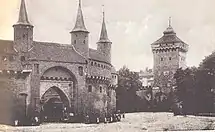Kraków Barbican
The Kraków Barbican (Polish: Barbakan Krakowski) is a barbican – a fortified outpost once connected to the city walls. It is a historic gateway leading into the Old Town of Kraków, Poland. The barbican is one of the few remaining relics of the complex network of fortifications and defensive barriers that once encircled the royal city of Kraków in the south of Poland.[1][2] It currently serves as a tourist attraction and venue for a variety of exhibitions.[3]
 Branch of the Historical Museum of Kraków | |

| |
| Established | 1498 |
|---|---|
| Location | Kraków, Poland |
| Coordinates | 50.06549°N 19.94164°E |
| Manager | Małgorzata Niechaj |
| Director | Michał Niezabitowski |
| Curator | Małgorzata Niechaj |
| Public transit access | Miejskie Przedsiębiorstwo Komunikacyjne w Krakowie |
| Website | mhk |
| Kraków Barbican | |
Barbakan krakowski | |
| Type | Polish Gothic outpost |
| Site history | |
| Built | 1498 |
Today the Barbican is under the jurisdiction of The Historical Museum of the City of Kraków. Tourists may tour its interior with its displays outlining the historical development of fortifications in Kraków.[4]
History
The Gothic-style barbican, built around 1498, is one of only three such fortified outposts still surviving in Europe, and the best preserved. It is a moated cylindrical brick structure with an inner courtyard 24.4 meters in diameter, and seven turrets. Its 3-meter-thick walls hold 130 embrasures. The barbican was originally linked to the city walls by a covered passageway that led through St. Florian's Gate and served as a checkpoint for all who entered the city.[5]
The Poles built the barbican fearing an attack by the Ottoman Empire after the defeat of King John I Albert at the Battle of the Cosmin Forest.
The Barbican participated in the defense of Kraków in 1587 against the Siege of Kraków (1587) by Maximilian III, Archduke of Austria, in the Siege of Kraków (1655) and the Siege of Kraków (1657), and Russian troops during the Polish–Russian War of 1792.
The building was threatened with demolition early in the 19th Century. However, in 1817 two senators of the Free City of Kraków, Feliks Radwanski and Jan Librowski, convinced the Senate to preserve the Barbican and other parts of the old fortifications.
Design
The Barbican was originally a large, circular tower with an interior open space with a diameter of 25 m (82 ft). It was built of brick and stone and stood four stories tall. It had seven watch towers. The walls were about 3 m (9.8 ft) at their base and 0.5 m (1 ft 7.7 in) at the top. The Barbican's exterior gate, the Kleparz Gate, was protected by a large, semi-circular moat 2626 m (85.3 ft) wide and 6 m (19.7 ft) deep.
Features
Considered a masterpiece of medieval military engineering, the circular fortress of the Kraków's Barbakan was added to the city's fortifications along the coronation route in the late 15th century, based on Arabic rather than European defensive strategy.[3] On its eastern wall, a tablet commemorates the feat of a Kraków burgher, Marcin Oracewicz, who, during the Bar Confederation, defended the town against the Russians and shot their Colonel Panin, according to a legend, using a czamara button instead of a bullet.[6][7]
Gallery
 Kraków Barbican in the 1930s
Kraków Barbican in the 1930s Gate to the former fortified passage facing St. Florian's Gate to the south
Gate to the former fortified passage facing St. Florian's Gate to the south Kraków Barbican modern entrance
Kraków Barbican modern entrance Barbican's defensive walls and the connecting bridge from before their 19th century dismantlement
Barbican's defensive walls and the connecting bridge from before their 19th century dismantlement
See also
- Planty Park, which encircles Kraków's Old Town (Stare Miasto)
- Warsaw Barbican
Notes
- Ministry of Foreign Affairs 2002–2009, The Sites on the UNESCO List. Krakow, at Poland.gov.pl
- Jane Perlez, Cracow Emerges From the Shadows in the New York Times, July 18, 1993.
- Mieczyslaw Kasprzyk, The Walls, Barbakan and the Florianska in "Krakow" from the Internet Archive
- Museum's History at the Museum's Home page (in Polish)
- This article incorporates information available at the Polish Wikipedia, including English text at Verbia – Guided tours of Krakow Archived 2008-05-31 at the Wayback Machine
- Beata Moore, Cracow: City of Treasures, 112 pages. Published by Frances Lincoln, ISBN 0-7112-2571-0
- Kraków – City portrait Archived 2008-06-08 at the Wayback Machine at Compress VerlagsgesmbH, Wien, Österreich
Bibliography
External links
![]() Media related to Barbakan in Kraków at Wikimedia Commons
Media related to Barbakan in Kraków at Wikimedia Commons
- How to get there?
- Kraków Poland: information about and photographs of Kraków's Barbican